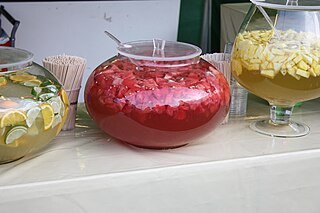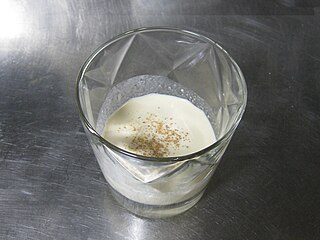
Mulled wine, also known as spiced wine, is an alcoholic drink usually made with red wine, along with various mulling spices and sometimes raisins, served hot or warm. It is a traditional drink during winter, especially around Christmas. It is served at Christmas markets in Europe. There are non-alcoholic versions of it. Vodka-spiked mulled wine can be found in Polish Christmas markets, where mulled wine is commonly used as a mixer.

The term punch refers to a wide assortment of drinks, both non-alcoholic and alcoholic, generally containing fruits or fruit juice. The drink was introduced from the Indian subcontinent to England by employees of the East India Company in the late 17th century. Punch is usually served at parties in large, wide bowls, known as punch bowls.

Eggnog, historically also known as a milk punch or an egg milk punch when alcoholic beverages are added, is a rich, chilled, sweetened, dairy-based beverage. It is traditionally made with milk, cream, sugar, egg yolks, and whipped egg whites. Distilled spirits such as brandy, rum, whisky or bourbon are often a key ingredient.

Rice pudding is a dish made from rice mixed with water or milk and other ingredients such as cinnamon, vanilla and raisins.

A hot toddy, also known as hot whiskey in Ireland, is typically a mixed drink made of liquor and water with honey, herbs and spices, and served hot. Hot toddy recipes vary and are traditionally drunk before retiring for the night, in wet or cold weather or to relieve the symptoms of the cold and flu. In How to Drink, Victoria Moore describes the drink as "the vitamin C for health, the honey to soothe, the alcohol to numb."

A sour is a traditional family of mixed drinks. Sours belong to one of the old families of original cocktails and are described by Jerry Thomas in his 1862 book How to Mix Drinks.

A liqueur coffee is a caffeinated alcoholic drink that consists of a shot of liqueur, mixed with coffee. It is typically served in a liqueur glass, accompanied many times with cream and sugar. Coffee liqueur beverages are served in different fashions and can be found throughout many countries. One of the most popular liqueur coffee beverage is commonly known as Irish coffee. Liqueur coffee beverages are largely classified as cocktails as well as digestifs which are aimed at aiding the digestive process typically after a meal.

A beer cocktail is a cocktail that is made by mixing beer with other ingredients, such as a distilled beverage or another style of beer. In this type of cocktail, the primary ingredient is beer.

Cocktail garnishes are decorative ornaments that add character or style to a mixed drink, most notably to cocktails.

Milk punch is a milk-based brandy or bourbon beverage. It consists of milk, the spirit, sugar, and vanilla extract. It is served cold and usually has nutmeg sprinkled on top. Milk punch may be clarified through the addition of ingredients which cause the milk to curdle, so that the solids contributing to the beverage's opacity may be strained out.

Hot buttered rum is a mixed drink containing rum, butter, hot water or cider, a sweetener, and various spices. It is especially popular in the fall and winter and is traditionally associated with the holiday season. In the United States, the drink has a lengthy history that dates back to colonial days. During that time many families had their own individual recipes, and early Americans believed rum to be nutritious and a strengthener of the body.
A sling is a drink that, in its classic form, is made with sugar, hot or cold water, nutmeg, and a spirit such as gin, whiskey, rum, or brandy. In its modern form, it is made with gin, sweet vermouth, lemon juice, simple syrup, Angostura bitters, and soda water. The word sling comes from the German schlingen, meaning "to swallow".

The cuisine of New Orleans encompasses common dishes and foods in New Orleans, Louisiana. It is perhaps the most distinctively recognized regional cuisine in the United States. Some of the dishes originated in New Orleans, while others are common and popular in the city and surrounding areas, such as the Mississippi River Delta and southern Louisiana. The cuisine of New Orleans is heavily influenced by Creole cuisine, Cajun cuisine, and soul food. Seafood also plays a prominent part in the cuisine. Dishes invented in New Orleans include po' boy and muffuletta sandwiches, oysters Rockefeller and oysters Bienville, pompano en papillote, and bananas Foster, among others.













